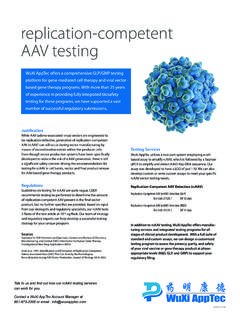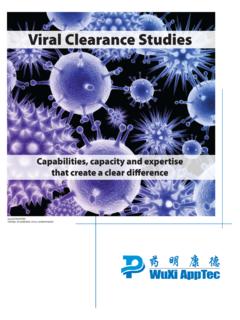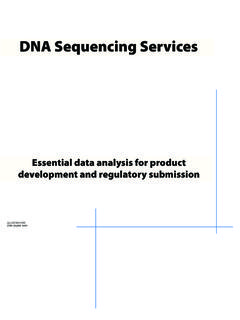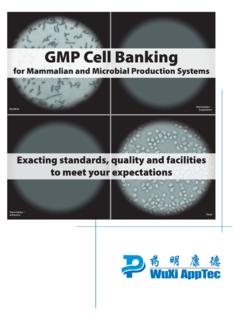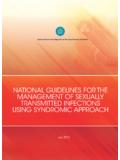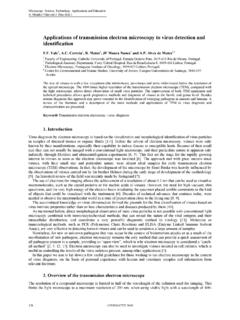Transcription of Guidelines to Mycoplasma Testing for Biologics - …
1 Guidelines to Mycoplasma Testing for Biologics Overview Guidelines for Mycoplasma Testing of biotherapeutics is addressed in several international pharmacopoeias ( , United States Pharmacopoeia (USP), European Pharmacopoeia [EP] and Japanese Pharmacopoeia [JP]), Section 21 of the Code of Federal Regulations (CFR), International Conference on Harmonisation (ICH), and Food and Drug Administration (FDA) Points to Consider (PTC) documents. This document provides a brief summary of the test methods available, sample requirements for Testing the most common types of biological products, and outlines existing regulations and current industry practice.
2 Exceptions may exist depending on the product and the process from which the product was generated. Mycoplasma Testing Methods The various international pharmacopoeia, CFR and other guidance documents provide protocols for Testing biological samples. Below are the various methodologies employed for detecting Mycoplasma from biological test samples: Direct Assay (Microbiological Culture) The direct method requires the test article be directly introduced to plate agar and liquid growth media (broth) capable of growing a variety of Mycoplasma including aerobic, microaerophilic and anaerobic strains. (See table on reverse.) Broth cultures are incubated and subpassaged to plate agar.
3 After the required incubation period, the agar plates are observed microscopically for the presence of Mycoplasma colonies. Indirect Assay (Indicator Mammalian Cell Culture) The indirect method requires the test article be inoculated directly onto tissue culture cover slips or flasks containing a monolayer of indicator cells (VERO cells are the most commonly used). The cells on cover slips are fixed and stained using a DNA binding stain (such as Hoechst stain) and identification of contaminating Mycoplasma is by visual observation via fluorescent microscopy. Mycoplasma PCR Specific oligonucleotide primers capable of amplifying and detecting multiple species of Mycoplasma DNA while excluding other contaminating DNA are used in polymerase chain reaction (PCR) or other nucleic acid amplification techniques (NAT).
4 The JP provides a specific protocol and the EP provides Guidelines describing acceptable protocols for PCR method validation and comparability studies. The pharmacopoeias, PTC, and CFR protocols vary with their recommen-dations on how to conduct the indirect and direct assays. The majority of biological samples will be tested using either the PTC or USP/EP in vitro-based protocols. However, the USP & EP allow for PCR Testing if a method validation program is conducted and comparability is demonstrated. Consulting with the appropriate regulatory authorities is recommended before using PCR for detection of Mycoplasma for regulatory submissions.
5 WuXi AppTec provides Mycoplasma Testing protocols that comply with PTC, USP/EP and 21 CFR Guidelines as well as several PCR methods. Customized Testing protocols and programs can be provided for those clients with additional requirements, , gene or cell therapy products, raw materials or 9 CFR and Barile (high volume) methodologies. See reverse for a table detailing the differences in Mycoplasma Testing methods. Mycoplasma Test Qualification (Mycoplasmastasis) It is important to determine if the test article that will be tested for Mycoplasma contains elements (product-specific growth inhibitors) that will interfere with the growth of any Mycoplasma contaminant (contained within the sample) in the growth media used for the assay.
6 This qualification Testing is commonly referred to as a mycoplasmastasis test. Although the 21 CFR and the FDA PTC Guidelines do not reference a mycoplasmastasis test requirement, the EP and JP do recommend conducting a Mycoplasma -stasis test. The qualification test is typically required only once for a given sample type, provided that no changes to the source, product, formulation or manufacturing process occur. Testing Requirements by Test Article Type For the following product types, the test method of choice can depend on the geographic location of the regulatory submission or product type. In addition, where appropriate, providing the sample in conditioned media and free of selective reagents ( , methotrexate, antibiotics) is desired.
7 If PCR assays are used, 4-5 mL of sample is recommended for Testing . Cell Line Testing (Cell Banks/Stocks, Cell Therapy Products) Cell stocks require Mycoplasma Testing as a quality control measure prior to the start of GMP cell banking or product manufacturing activities. Likewise, once GMP manufactured cell banks are generated, Mycoplasma Testing is required as part of cell line characterization programs. For autologous cell therapy programs, it is acceptable to perform PCR Mycoplasma assays to take advantage of reduced turnaround times. An in vitro method is typically conducted in parallel with the PCR methods to provide additional assurance that the test article is Mycoplasma free.
8 For all cell line Testing , a single vial or sample of the cell bank ( x 106 to x 107cells) can be expanded to provide the necessary volume required for Testing . Viral Banks/Stocks, Viral Gene Therapy, Viral Vaccine Products Virus banks or stocks require Mycoplasma Testing as part of a quality control measure prior to GMP activities, as a requirement for viral bank characterization programs, and as part of a viral product lot release program. Typically Mycoplasma lot release Testing is conducted on the bulk viral harvest. Virus products that are toxic, replication competent or capable of infecting the indicator cell line may require modifications to the standard Mycoplasma test protocols by using a non-permissive cell line ( , NIH/3T3), diluting the test article, or using a neutralization antibody.
9 In most cases involving protocol changes, additional assay qualification (mycoplasmastasis) may be required. Often it is not practical for viral product manufacturers to supply the entire volume of test article required for Mycoplasma assays due to factors such as sample availability or lot size. In these instances, a patient dose may be relevant. If possible, x 1010 virus particles may also be acceptable. In such cases, the test article would be diluted to appropriate total volume required for the protocol. For PCR methods, a single patient dose may be relevant. End of Production Cells Testing (For Protein Products) Within the biotherapeutics industry, end of production cells has many other names, including cell harvest, unprocessed bulk, clarified cell harvest or cells at the limit of in vitro cell age.
10 In all cases, Mycoplasma Testing is required and typically the full volume of the test article can be provided. Bulk Drug Substance (BDS) and Final Drug Product (DP) Testing (For Protein Products) Mycoplasma Testing is not recommended nor required on BDS or DP of protein therapeutics that undergo standard purification processes. Mycoplasma Testing for Biologics (continued) Conclusion Mycoplasma contamination of cell lines and biotherapeutic products represents a significant biosafety concern. The ubiquitous nature of Mycoplasma in man, animals and the environment increases the likelihood of the introduction of these organisms into cell lines or a manufacturing process. WuXi AppTec offers a variety of Mycoplasma detection protocols to address your research and regulated Testing needs, ensuring product quality and safety during different stages of pharmaceutical development.

